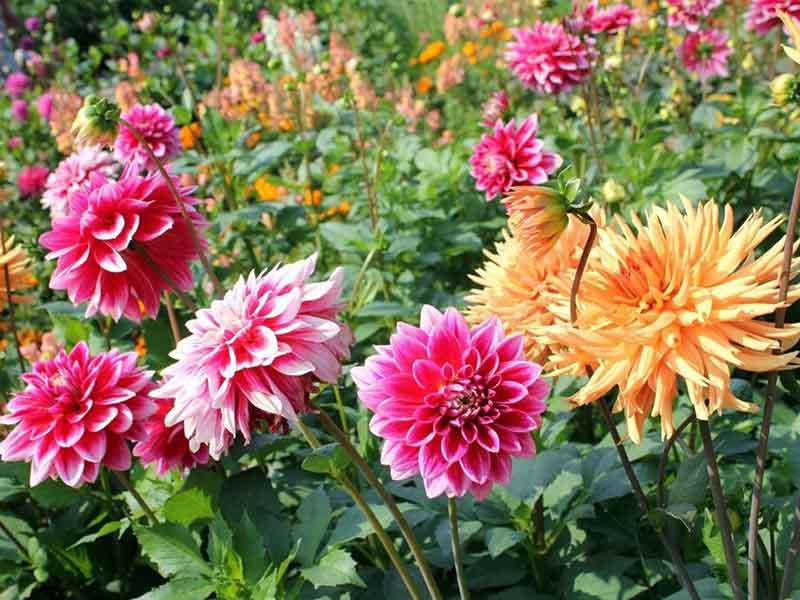The Ultimate Guide to Growing Dahlias in Georgia
Introduction
The secret to a successful dahlia garden lies in understanding Georgia's climate and soil. Here's your guide to growing magnificent dahlias in the Peach State.
Selecting the Right Varieties for Georgia
Choosing Varieties Suited to Georgia's Climate
The first step to a successful dahlia garden is choosing varieties. Look for "Georgia-friendly" dahlias. This typically means selecting those with a tolerance for heat and high humidity.
Opt for cultivars renowned for thriving in Southern states. For example, the Bishop's Children series has dark and dramatic foliage, Jitterbug has medium size and prolific flowering, or the City of Leiden has warm orange petals.
Heat Tolerance and Disease Resistance
Georgia gardens can be unforgiving in the height of summer. Dahlias susceptible to rot or foliar diseases will struggle. Some varieties have robust immune systems against common dahlia diseases. It also performs admirably in sweltering conditions. For example, the Mystic series or the Firepot cultivar boast.
Preparing the Soil
Soil Testing and Amendment
The success of your dahlia garden is entrenched in the vitality of the soil. Georgia's red clay is notorious for its heavy texture and poor drainage. Start by testing its soil pH levels. Dahlias prefer slightly acidic soil with a pH 6.5-7.0.
Improving Drainage and Fertility
Amend the soil with organic matter to improve texture and fertility. For example, compost, leaf mold, and even pine bark. Adding sand or perlite can aid in expediting drainage. This is essential to avoid waterlogging.
How to Grow Dahlias in Georgia?
When to Plant Dahlia Bulbs in Georgia?
Timing is everything when planting dahlias in Georgia. The best timeframe is from late March to April. These months are typically free from frost.
Planting before the last frost date can be risky. So keep an eye on local weather forecasts. If you've missed the ideal window, you can still plant as late as May. But your blooms might be delayed.
Planting Your Dahlia Bulbs
Dig a hole 6 to 8 inches deep when growing dahlias in Georgia. Add a bit of compost to the bottom to enrich the soil. Place your dahlia tuber in the center with the bud, or growing point, facing upwards.
Ensure the hole is deep enough. Cover the tuber with about 2 inches of soil. Proper spacing is crucial, especially in Georgia's humid climate. So place each dahlia about 1 to 3 feet apart, depending on the variety.
Watering Newly Planted Dahlias
Water your newly planted dahlias thoroughly but gently. Use a watering can or soaker hose to moisten the soil without disturbing the tubers. After the initial watering, continue to keep the soil consistently moist, not waterlogged. Until you see the first shoots emerge.

Caring for Dahlias
Watering Requirements
The Georgia summer is known for its heat, and dahlias are thirsty plants. Throughout the growing season, it's critical to water regularly. Ensure the soil remains evenly moist but not waterlogged.
Use a soaker hose or drip irrigation to deliver water at the base of the plant. This minimizes the risk of fungal diseases. These are common in Georgia's humid climate.
Fertilization Schedule
Start with a balanced fertilizer when you first plant. Then, switch to a high-phosphorous fertilizer to enhance blooming once you see the first buds.
Repeat this application every four to six weeks until the fall. In Georgia, slow-release fertilizers can also be advantageous. They provide a steady source of nutrients to your dahlias.
Control Pests and Diseases
Pests and diseases can be a significant threat to dahlias in Georgia. For example, gastropods, aphids, spider mites, and earwigs. Neem oil or insecticidal soap can be effective, natural remedies.
Disease-wise, disorders can strike, especially in the humid summer. For example, gray mold, powdery mildew and fungal rots. Apply appropriate fungicides according to label instructions if you notice signs of disease.
Staking and Supporting Dahlias
Importance of Staking Dahlias
Staking helps maintain the vertical structure of the plant. This is essential for even sunlight exposure and proper air circulation. A braced dahlia plant is less susceptible to damage from the elements.
Different Staking Methods and Materials
There is a variety of staking methods, ranging from single stakes to circular cages. Georgia can face strong summer storms. You should use ample and durable staking materials. For example, metal stakes or bamboo poles. These materials can withstand extended exposure to high humidity. They are also less prone to decay.
Tips for Supporting Taller Dahlia Varieties
Tall dahlia varieties may reach four feet or more. You should stake the plant at several points along its height, creating a "cage" of support. You can use twine or soft fabrics to tie the stems to the stakes. Ensure they are secure without damaging the plant.
Dahlia Maintenance
Deadheading Dahlias
Remove spent blooms to deadhead your dahlias. This encourages more flowering throughout the season. By doing this, you prevent the plant from diverting energy to seed production and instead focus on creating more flowers.
Dividing and Storing Dahlia Tubers
After the first frost in the late fall, carefully dig up dahlia tubers. Rinse off the soil and leave it out to dry for a day or two. Store tubers in a cool, dry place. For example, a basement or garage. Ensure they don't freeze.
Dividing tubers every couple of years maintains plant health and vigour. A few weeks before you plan to plant them again. Divide the clumps ensuring each division has an 'eye.' Apply a fungicide if any cut surfaces appear damaged or infected.
Conclusion
Mastering how and when to plant dahlias in Georgia. With patience and diligence, you can enjoy a spectacular display of color year after year.

